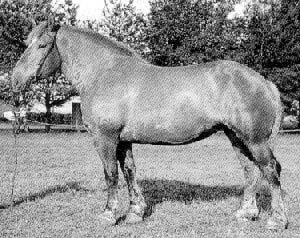Soviet Heavy Draft
N/A
Sun, 20th April, 2025 - 1:11 pm GMT
Sponsor Ads:

Alternative Name
N/ABasic Info
Modern purebred Soviet Heavy Drafts are distinguished by ample height and clearly expressed harness type. They are heavily muscled and boned. The average measurements of breeding stallions at the studs (in cm) are: height withers 163, oblique body length 172, chest girth 215, cannon bone girth 25; mare: 160, 168, 205 and 22.75 respectively. The live weight of stallions is 850 kg and sometimes reaches 1000 kg; the mares' weight is 650-750. The Soviet Draft has the following characteristics: the head is average in size and clean-cut, the neck is average in length, often on the short side and well muscled; the withers ar low; the back is long, often slightly dipped, the loin is average in length, the croup is broad, furrowed, drooping and heavily muscled, the chest is broad, average in depth, the ribs are well sprung. the forelegs are often pigeon-toed and the hind ones are sickle-hocked. The build is quite coarse, soft and yet much cleaner and more solid than that of the Brabancon. The predominant colours are chestnut, brown and bay.
Health
N/AHabitat
N/ABehavior
The Soviet Heavy Draft mature extremely early and era good milk and meat producers. With normal feeding and management the foalf at weaning attain a live weight of 360-400 kg. The breed's record milk yield is 6320 kg. they have a good weight gain per fodder unit but demand good management. they are unsufficiently disease resistant and adapt to extreme manapement conditions worse that other breeds do. The mares' fertility varies from 65 to 76%. The breed comprises 2 lines and 3 mare families. A new line is now being developed.Origin
N/AHistory
This breed was developed during the period from the '80s and the '90s of the last century up to 1952 when it was recognized as a new heavy Draft breed. The breeding zone was quite extensive, including Yaroslavl, Vladimir, Gorki, Penza, Ryazan, Tula, tambov, Voronezh and Orel regions and Mordovia. This was a zone with a developed industry and intensive agriculture, requiring strong and sufficiently fast horses of ample size. Success in the breeding of this type of horse was guaranteed by a stable supply of fodder. As the intensification of agricultural production proceeded, demand for massive heavy Drafters was growing. The influence of Brabancon began to spread. In the Baltic zone, new breeds, the Lithuanian and the Estonian Heavy Draft, began to be formed on a different local mare basis. The leading breeding centres are Pochikovsk atud in Gorki region and the Mordovian stud farm.Common Foods
grassSponsor Ads:
If someone gives you so-called good advice, do the opposite; you may be certain that that will be the right thing nine times out of ten. -- Unknown
Soviet Heavy Draft
Coded by: BGID® | ALL RIGHTS RESERVED Copyright © 2000-2025
Disclaimer | Privacy | Report Errors / Contact | Credits








 Preparing For China. China is growing their military. China Military Technology - can it keep up with the US?
Preparing For China. China is growing their military. China Military Technology - can it keep up with the US?  versus
versus 

 versus
versus 
 This Thread is about the North Korean Military itself - the kind of army, navy, and air force they have.
This Thread is about the North Korean Military itself - the kind of army, navy, and air force they have. 
 versus
versus 
 versus
versus  versus
versus